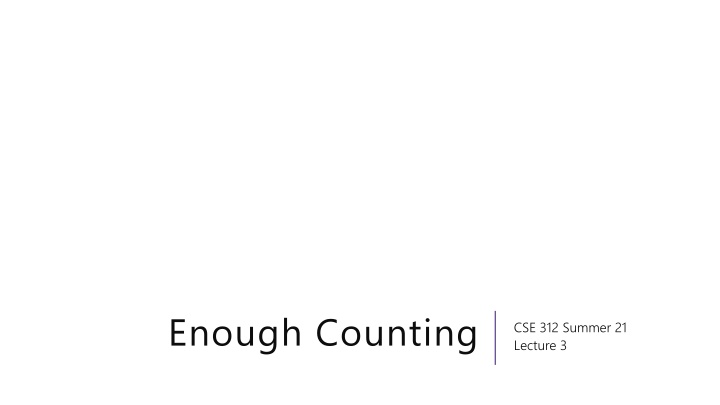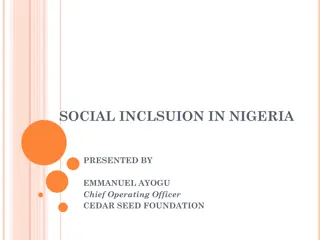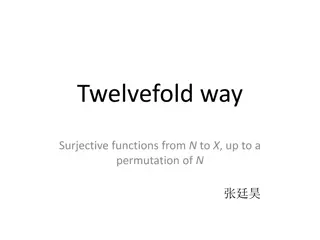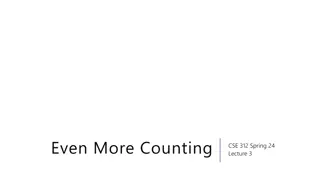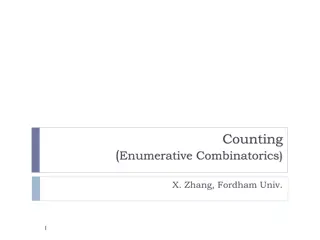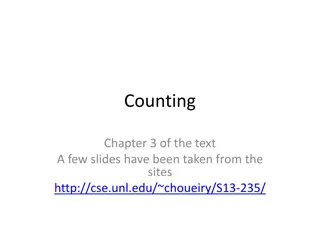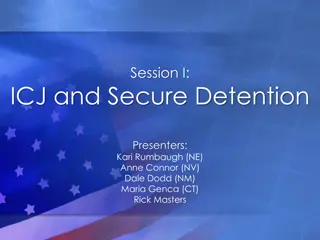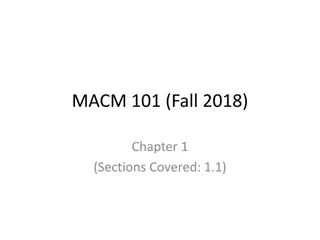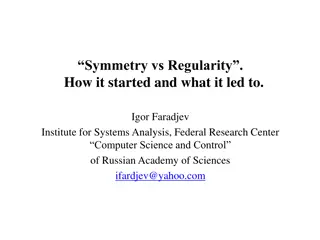Principles of Inclusion-Exclusion in Combinatorics
Explore the principles of inclusion-exclusion in combinatorics, focusing on scenarios involving sets and intersections. Learn how to calculate the number of strings that contain specific elements by applying these principles effectively, with detailed examples and explanations.
Download Presentation

Please find below an Image/Link to download the presentation.
The content on the website is provided AS IS for your information and personal use only. It may not be sold, licensed, or shared on other websites without obtaining consent from the author.If you encounter any issues during the download, it is possible that the publisher has removed the file from their server.
You are allowed to download the files provided on this website for personal or commercial use, subject to the condition that they are used lawfully. All files are the property of their respective owners.
The content on the website is provided AS IS for your information and personal use only. It may not be sold, licensed, or shared on other websites without obtaining consent from the author.
E N D
Presentation Transcript
Enough Counting CSE 312 Summer 21 Lecture 3
Announcements Syllabus is up! Problem Set 1 is out! Due next Thursday 11:59 pm. Office Hours start today! Please start early.
Outline So Far Sum and Product Rules Combinations and Permutations Introduce ordering and remove it to make calculations easier Binomial Theorem This Time Principle of Inclusion-Exclusion Pigeonhole Principle Stars and Bars
Example How many length 5 strings over the alphabet {?,?,?, ,?} contain: Exactly 2 a s OR Exactly 1 b OR No x s
Principle of Inclusion-Exclusion The sum rule says when ? and ? are disjoint (no intersection), then ? ? = ? + |?|. What about when ? and ? aren t disjoint? ? ? ? ? For two sets: ? ? = ? + ? |? ?|
Principle of Inclusion-Exclusion For three sets: ? ? ? = ? + ? + ? ? ? ? ? ? ? + |? ? ?| ? ? ?
In general: ?1 ?2 ?? = ?1+ ?2+ + ?? ?1 ?2+ ?1 ?3+ + ?1 ??+ ?2 ?3+ + ?? 1 ?? +( ?1 ?2 ?3+ + ?? 2 ?? 1 ??) + 1?+1|?1 ?2 ??| Add the individual sets, subtract all pairwise intersections, add all three-wise intersections, subtract all four-wise intersections, , [add/subtract] the ?-wise intersection.
Example How many length 5 strings over the alphabet {?,?,?, ,?} contain: Exactly 2 a s OR Exactly 1 b OR No x s For what ?,?,? do we want |? ? ?|?
How many length 5 strings over the alphabet {?,?,?, ,?} contain: Exactly 2 a s OR Exactly 1 b OR No x s Example ? = {length 5strings that contain exactly 2 a s} ? = {length 5strings that contain exactly 1 b s} ? = {length 5strings that contain no x s } 5 2 253(need to choose which spots are a and remaining string) 5 1 254 ? = 255 ? = ? =
How many length 5 strings over the alphabet {?,?,?, ,?} contain: Exactly 2 a s OR Exactly 1 b OR No x s Example 5 2 253 5 1 253 ? = {length 5 strings that contain exactly 2 a s} ? = {length 5 strings that contain exactly 1 b s} ? = {length 5 strings that contain no x s } ? = ? = ? = 255 3 1 242(choose a spots, b spot, remaining chars) 5 2 5 2 243(choose a spots, remaining [non- x ] chars) 5 1 244 5 2 ? ? = ? ? = ? ? = ? ? ? = 3 1 232(choose a spots, b spot, remaining [non- x ] chars)
How many length 5 strings over the alphabet {?,?,?, ,?} contain: Exactly 2 a s OR Exactly 1 b OR No x s Example 5 2 253 5 1 254 ? = ? = ? = 255 ? ? ? = = ? + ? + ? ? ? ? ? ? ? + |? ? ?| =5 =11,875,000 ? ? ? ? ? ? + ? ? ? = 11,875,000 2 = 11,875,000 1,814,400 + ? ? ? = 10,060,600 + |? ? ?| = 10,060,600 + 2 = 10,060,600 + 15,870 = 10,076,470 2 253+ 5 1 254+255 ? ? ? ? ? ? + ? ? ? 5 2 5 2 243 5 1 244 3 1 242 ? ? = 5 3 1 242 5 2 243 5 1 244+ ? ? ? ? ? = 5 3 1 232 ? ? = 5 2 3 1 232 ? ? ? =
Practical tips Give yourself clear definitions of ?,?,?. Make a table of all the formulas you need before you start calculating. Calculate size-by-size and incorporate into the total. Basic check: If (in an intermediate step) you ever: 1. Get a negative value 2. Get a value greater than the prior max by adding (after all the single sets) 3. Get a value less than the prior min by subtracting (after all the pairwise intersections) Then something has gone wrong.
Pigeonhole Principle If you have 5 pigeons, and place them into 4holes, then At least two pigeons are in the same hole.
Pigeonhole Principle If you have 5 pigeons, and place them into 4holes, then At least At least two pigeons are in the same hole. It might be more than two.
Strong Pigeonhole Principle If you have ? pigeons and ? pigeonholes, then there is at least one pigeonhole that has at least ? ? pigeons. ? is the ceiling of ? (it means always round up, 1.1 = 2, 1 = 1).
An example If you have to take 10 classes, and have 3 quarters to take them in, then Pigeons: The classes to take Pigeonholes: The quarter Mapping: Which class you take the quarter in. Applying the (generalized) pigeonhole principle, there is at least one quarter where you take at least 3 10 = 4 courses.
Practical Tips When the pigeonhole principle is the right tool, it s usually the first thing you d think of or the absolute last thing you d think of. When applying the principle, say: What are the pigeons What are the pigeonholes How do you map from pigeons to pigeonholes Look for a set you re trying to divide into groups, where collisions would help you somehow.
One More Counting Rule You re going to buy one-dozen donuts (i.e., 12 donuts) There are chocolate, strawberry, coconut, blueberry, and lemon (i.e. five types) How many different donut boxes can you buy? Consider two boxes the same if they contain the same number of every kind of donut (order doesn t matter)
One More Counting Rule You re going to buy one-dozen donuts (i.e., 12 donuts) There are chocolate, strawberry, coconut, blueberry, and lemon (i.e. five types) Put donuts in order by type, then put dividers between the types. Counting the number of ways to place dividers instead.
Placing Dividers Place a divider how many possible locations are there? 13 before donut 1, before 2, , before donut 12, after donut 12.
Placing Dividers Place a divider how many possible locations are there? 13 before donut 1, before 2, , before donut 12, after donut 12. Place the second divider, how many possible locations are there? 14 one of the previous spots was split ( before and after the last divider)
Placing Dividers Place a divider how many possible locations are there? 13 before donut 1, before 2, , before donut 12, after donut 12. Place the second divider, how many possible locations are there? 14 one of the previous spots was split ( before and after the first divider) In general, placing divider ? has 12 + ? possible locations.
Wrapping Up We had 12 donuts, how many dividers do we need? 4 (to divide into 5 groups) Count so far: 13 14 15 16 Are we done?
Wrapping Up Count so far: 13 14 15 16 This count treats all dividers as different they re not! Divide by 4!. For ? donuts of ? types ?+1 ?+2 ?+? 1 (? 1)! That s a combination! ?+? 1 ? 1
Wrapping Up ?+? 1 ? 1 We wrote down a string consisting of ? and ? 1 ? + ? 1 characters, ? donuts are identical, ? 1 dividers are identical, so divide by the rearrangements (like we did for SEATTLE).
In General To pick ? objects from ?groups (where order doesn t matter and every element of each group is indistinguishable), use the formula: ? + ? 1 ? 1 The counting technique we did is often called stars and bars using a star instead of a donut shape, and calling the dividers bars
Weve seen lots of ways to count Sum rule (split into disjoint sets) Product rule (use a sequential process) Combinations (order doesn t matter) Permutations (order does matter) Principle of Inclusion-Exclusion Complementary Counting Stars and Bars ?+? 1 ? 1 Niche Rules (useful in very specific circumstances) Binomial Theorem Pigeonhole Principle
Practice How do we know which rule to apply? PRACTICE! PRACTICE! PRACTICE! But if as you are working you realize that things are getting out of control, put it aside and try something different.
Cards A standard deck of cards has 52 cards. Each card has a suit diamonds , hearts , clubs , spades and a value (Ace,2,3,4,5,6,7,8,9,10,Jack,Queen, King). A 5-card-hand is a set of 5 cards How many five-card flushes are there? a flush is a hand of cards all of the same suit.
Cards How many five-card flushes are there? a flush is a hand of cards all of the same suit. Way 1: How can I describe a flush? Which suit it is, and which values: 4 1 13 5
Cards Way 2: Pretend order matters. The first card can be anything, After that, you ll have 12 options (the remaining cards of the suit), then 11, Then divide by 5!, since order isn t supposed to matter. 52 12 11 10 9 5! This is the same number as what we got on the last slide! = 4 13 12 11 10 9 5! = 4 52 12 11 10 9 5! 13! 5! 8!= 4 1 13 5
A Solution with a Problem You wish to count the number of You wish to count the number of 5 5- -card hands with at least There are 4 Aces (and 48 non aces) card hands with at least 3 3 aces. aces. 4 3 Choose the three aces. Then of the 49 remaining cards (the last ace is allowed as well, because we re allowed to have all 4) 49 2 What s wrong with this calculation? What s the right answer? Fill out the Poll Everywhere for Kushal to adjust his explanation Go to pollev.com/cse312su21
A Solution with a Problem For a hand, there should be exactly one set of choices in the sequential process that gets us there. {A , A , A } {A , K } And {A , A , A }, {A , K } Are two different choices of the process, but they lead to the same hand!
A Solution with a Problem We could count exactly which hands appear more than once, and how many times each appears and compensate for it. See the extra slides at the end. An easier solution is to try again The problem was trying to account for the at least come up with disjoint sets and count separately. 4 3 If there are exactly 3 aces, we choose which 3 of the 4, then choose which 2 cards among the 48 non-aces. If all 4 aces appear, then one of the remaining 48 cards finishes the hand. Applying the sum rule completes the calculation. 48 2 4 4 48 1 +
Takeaway It s hard to count sets where one of the conditions is at least X You usually need to break those conditions up into disjoint sets and use the sum rule.
Fruit Picking You have to choose 8 pieces of fruit. There are apples, oranges, and bananas. You need to pick at most 2 apples and at least 1 banana. How many sets of fruit can you choose?
Fruit Picking You have to choose 8 pieces of fruit. There are apples, oranges, and bananas. You need to pick at most 2 apples and at least 1 banana. How many sets of fruit can you choose? Divide into cases based on number of apples: 0 apples: 1 to 8 bananas possible (8 options) 1 apple: 1 to 7 bananas possible (7 options) 2 apples: 1 to 6 bananas possible (6 options) 21 total (by sum rule)
Fruit Picking You have to choose 8 pieces of fruit. There are apples, oranges, and bananas. You need to pick at most 2 apples and at least 1 banana. How many sets of fruit can you choose? Pick out your first banana. Problem is now to pick 7 fruits (at most 2 apples, allowed to take apples oranges and bananas) Ignore apple restriction, and subtract off when too many apples: Ignore restriction: 7+3 1 3 1 3 apples, 4+3 1 3 1 Total: 9 2 (choose 3 apples first, pick 4 remaining) 6 2= 36 15 = 21
Takeaways For donut-counting style problems with twists , it sometimes helps to just throw the first few in the box to get a problem that is exactly in the donut-counting framework. When you can do a problem two very very different ways and get the same answer, you get much more confident in the answer.
A Solution with a Problem You wish to count the number of 5-card hands with at least 3 aces. There are 4 Aces (and 48 non aces) 4 3 Choose the three aces. Then of the 49 remaining cards (the last ace is allowed as well, because we re allowed to have all 4) 49 2 What s wrong with this calculation?
The Problem When do we overcount? If there are exactly 4 Aces in the hand, then we count the hand 4 different times (once for each ace as an extra one): {A , A , A }, {A , ?} {A , A , A }, {A , ?} {A , A , A }, {A , ?} {A , A , A }, {A , ?}
How much do we overcount? There are 48 such hands (one for every card that could be ? on the last slide) So we ve counted 3 48 processes that shouldn t count. That would give a corrected total of 4 This is the same number as we got during lecture with our other counting. 49 2 3 3 48
